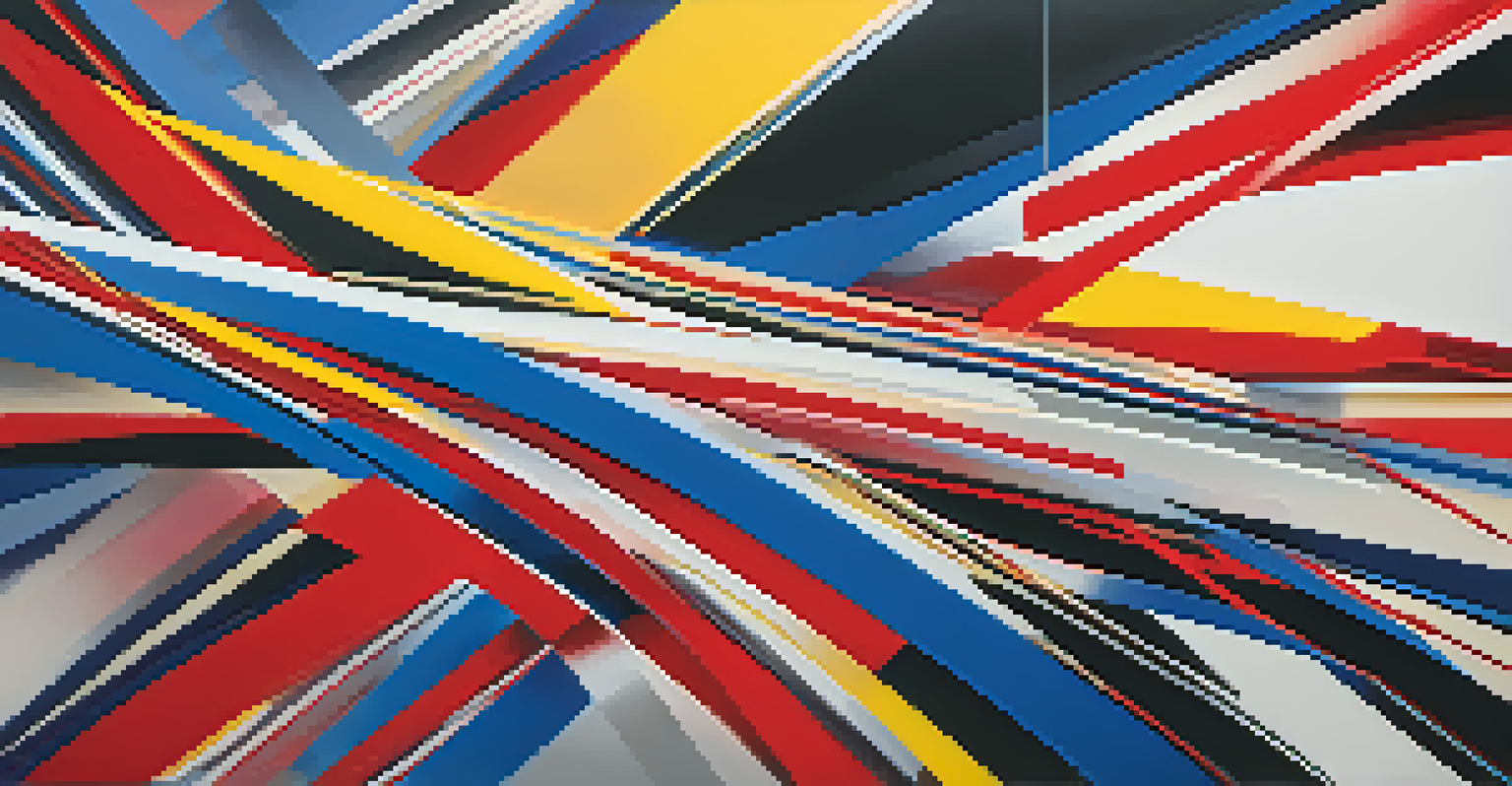The Power of Line: How Lines Create Meaning in Art

Understanding the Basics of Line in Art
Lines are the building blocks of visual art, serving as fundamental elements that create shapes and forms. They can be straight, curved, thick, or thin, each variation conveying different emotions and messages. For instance, a jagged line might evoke tension, while a smooth, flowing line can suggest calmness or serenity.
Lines are the most basic and essential element of any drawing, and they can express a multitude of ideas and emotions.
Artists often use lines to guide the viewer's eye through their work, creating a visual path that enhances storytelling. Think of a winding road in a landscape painting—lines can lead you on a journey, inviting you to explore every corner of the canvas. This directional quality of lines is essential in establishing a connection between the artwork and the observer.
Furthermore, lines can establish boundaries and separate elements within a piece, creating contrast and emphasizing specific areas. By manipulating line qualities, artists can draw attention to focal points, helping viewers understand the narrative or theme. In this way, lines are not just simple marks; they are powerful tools that shape our experience of art.
The Emotional Impact of Different Line Types
Different types of lines evoke different emotions, and artists strategically choose them to influence how we feel about a piece. For example, vertical lines often symbolize strength and stability, while horizontal lines can convey peace and tranquility. Understanding these nuances allows viewers to interpret art on a deeper level.

Curved lines, on the other hand, tend to express movement and fluidity. They can create a sense of rhythm and energy, often seen in dynamic compositions. Imagine a swirling line in a dance painting; it embodies motion and grace, captivating the viewer’s attention and imagination.
Lines Shape Art's Emotional Journey
Different types of lines evoke various emotions, influencing how viewers interpret and connect with artwork.
Jagged or irregular lines can introduce feelings of chaos or tension, effectively communicating conflict or unease. This emotional language of lines adds layers to the artwork, urging viewers to engage with the piece not just visually but also emotionally. Recognizing these emotional impacts can transform how one appreciates art.
Lines as Symbols: Cultural and Contextual Meanings
Lines often carry symbolic meanings that vary across cultures and contexts. For instance, in some traditions, a circle made from a continuous line may represent unity or eternity, while a broken line could symbolize disruption or change. Understanding these cultural associations can enrich our interpretation of art.
The line is a powerful tool in the hands of the artist; it can create texture, form, and movement all at once.
Moreover, the context in which lines are used can alter their significance. In modern abstract art, lines may challenge traditional representations, pushing boundaries and encouraging viewers to rethink their perceptions. This playful use of lines invites dialogue and reflection, making art a dynamic conversation.
As we engage with different artworks, being aware of these symbolic meanings can deepen our appreciation. It encourages us to look beyond the surface and consider the broader implications of how lines are utilized, enriching our overall experience.
The Role of Line in Composition and Balance
Composition is crucial in art, and lines play an essential role in creating balance and harmony. Artists often use lines to structure their compositions, guiding the viewer's gaze and ensuring that the elements within the artwork are well-aligned. A well-balanced composition can evoke a sense of stability and calm.
For example, the rule of thirds in photography and painting suggests that placing lines along certain grid lines can create a more engaging and balanced image. This technique draws the viewer's eye naturally across the piece, enhancing the visual experience. Consider how a horizon line can ground a landscape, providing a natural division that balances sky and land.
Lines Create Movement and Flow
Artists use lines to convey motion and direct the viewer's gaze, enhancing the storytelling within the art.
However, artists may intentionally disrupt balance using lines to create tension or dynamism. This manipulation can add energy to a piece, challenging conventional perceptions of harmony. Understanding this balance between chaos and order illuminates the artist's intent and the impact of lines on composition.
Lines and Movement: Conveying Motion in Art
Lines can be powerful indicators of movement, capturing action and energy within a static medium. Artists often employ diagonal lines to create a sense of dynamism, suggesting that something is happening or about to happen. For instance, in a painting depicting a runner, diagonal lines can emphasize the motion and speed.
In contrast, horizontal lines can imply rest or stillness, grounding the viewer in a moment of peace. This interplay between different line orientations can influence how we perceive the activity within the artwork. It's fascinating how a simple line can change the narrative from one of calm to one of excitement.
Moreover, lines can also lead the viewer's gaze in a specific direction, creating a visual flow that mimics movement. This technique can enhance storytelling, as it compels the viewer to follow the path laid out by the artist. By harnessing the power of lines, artists can create a captivating sense of movement that resonates with the audience.
The Intersection of Line and Texture in Art
Lines and texture often intersect in art, creating depth and complexity. Artists can use lines to mimic textures, enhancing the tactile quality of a piece. For example, short, repetitive lines can evoke the feel of rough surfaces, while smooth, flowing lines may suggest softness.
This relationship between line and texture can transform the viewer's experience, inviting them to engage with the artwork on a sensory level. When we see lines that appear to ripple or undulate, we can almost feel the texture beneath our fingertips, deepening our connection to the piece.
Symbolism of Lines in Culture
Lines carry cultural meanings and contexts, enriching our understanding and appreciation of art.
Furthermore, by contrasting different line qualities—such as combining thick, bold lines with delicate, fine lines—artists can create visual tension and interest. This dynamic interplay not only enriches the artwork but also encourages viewers to explore the nuances of line and texture, making the experience more immersive.
Line as a Narrative Device in Art
Lines can serve as powerful narrative devices, helping to tell a story within a work of art. The direction, thickness, and style of lines can guide viewers through a narrative, much like a plot unfolding in a book. For instance, a series of upward lines may suggest hope or ascension, while downward lines could indicate decline or despair.
Artists often use lines to create pathways, leading the viewer's eye across the canvas and inviting them to follow the story being told. This journey through the artwork can evoke emotions and provoke thought, making the viewer an active participant in the narrative.

Additionally, the interplay of lines can create tension and conflict within the story, mirroring the complexities of human experience. This ability to convey narrative through line is what makes art such a compelling medium for storytelling, allowing us to connect with the emotions and themes presented.